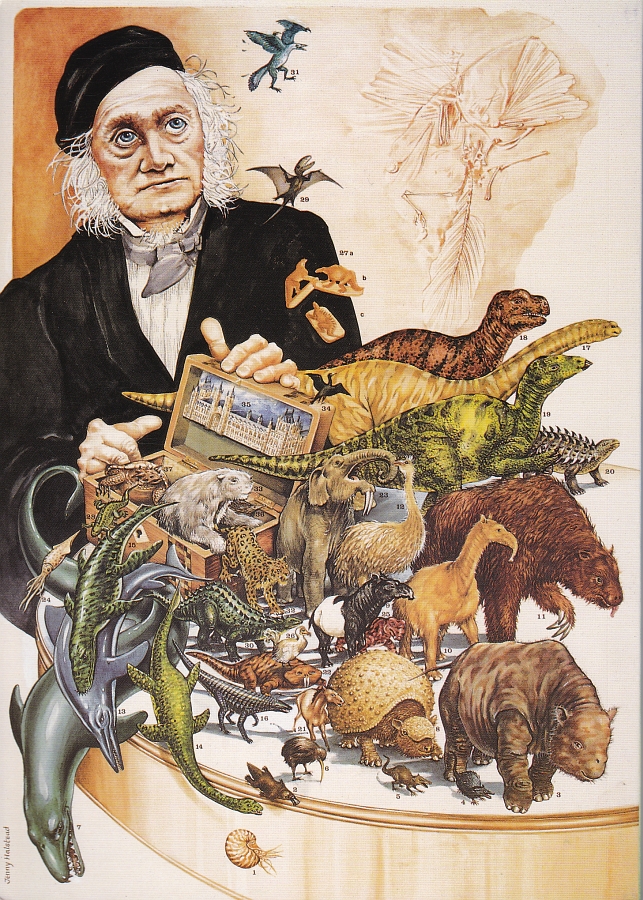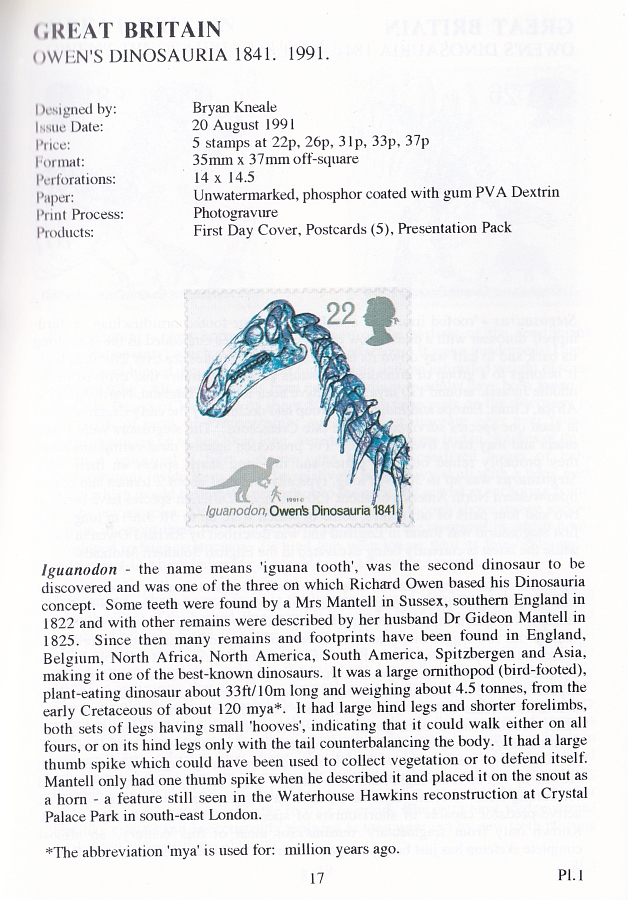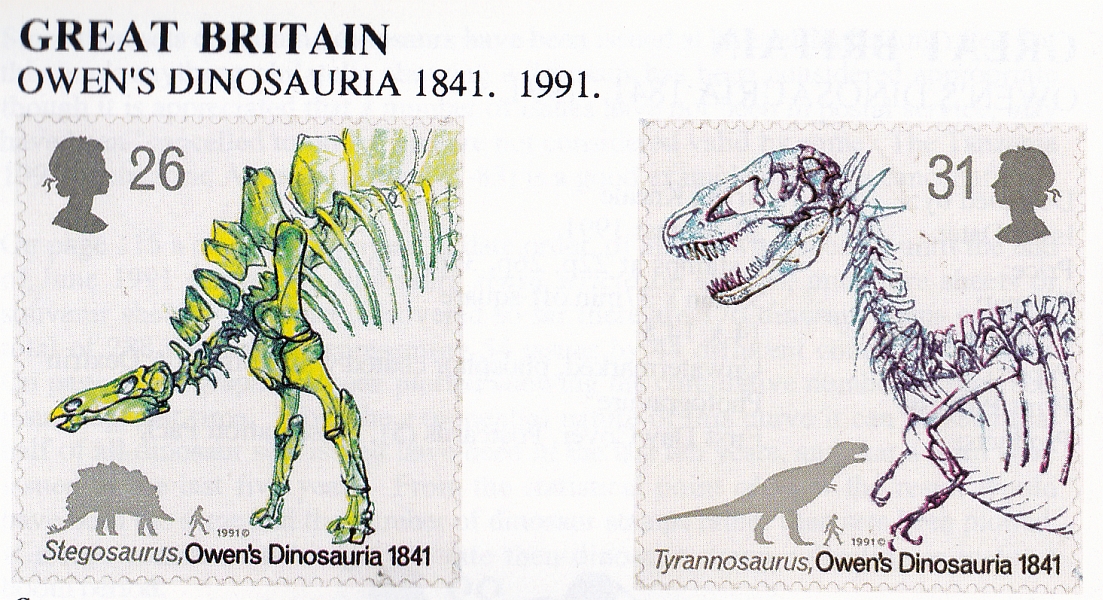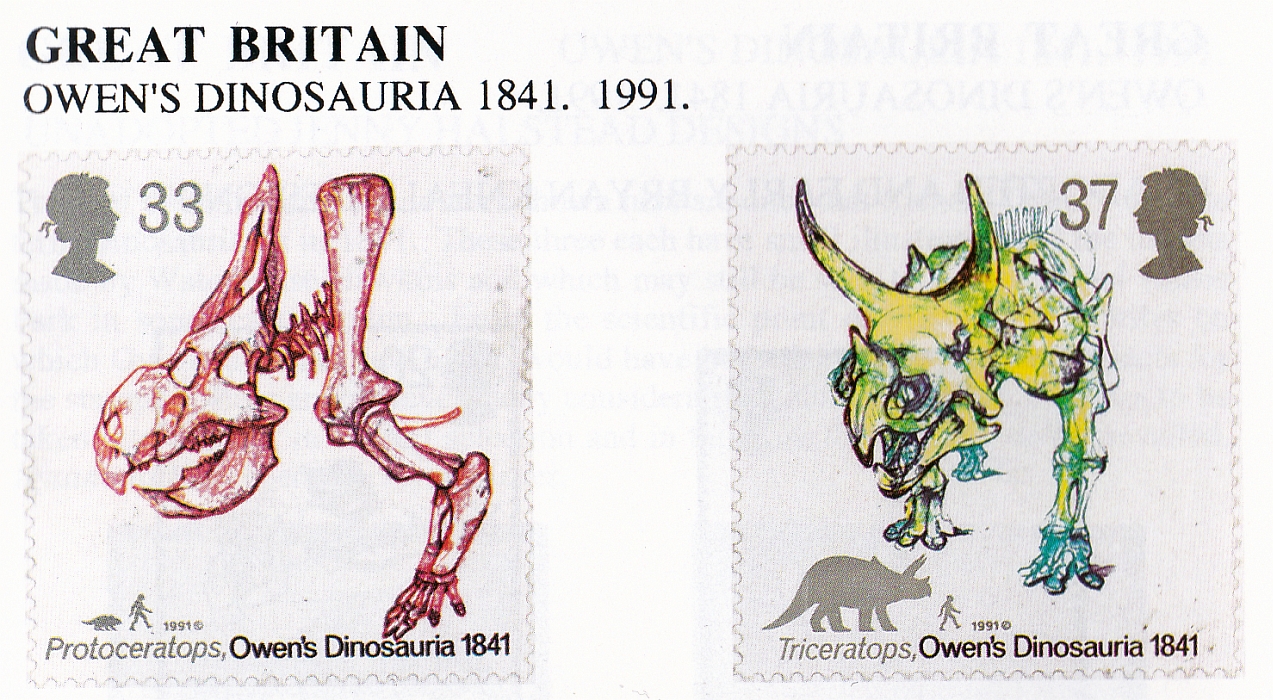Given that the sorts of people who are enthusiastic about dinosaurs and prehistory also tend to possess carefully curated collections of curious objects, it’s only natural that there’s a strong overlap with philately, that is to say, stamp collecting. (After all, isn’t all science other than physics merely stamp collecting?) I’ve never much been into it myself – I have just a couple of dinosaur-related sets, purely because of the dinosaurs – but it’s easy to see the appeal. Happily, the two hobbies were brought together in Dinosaur Stamps of the World, written by Stuart Baldwin with help from Beverly Halstead, and published by, er, Baldwin’s Books in 1991. It’s a highly endearing delve into palaeoartistic postage.

This book’s on loan to me from Agata Stachowiak, who found it in the Sedgwick Museum in Cambridge in 2019. As a child, Agata had a collection of dinosaurs stamps collated by her grandfather, who was a huge philaterer…ist. Sadly, they were lost to time, so she was very happy to chance upon this particular volume. The book’s production was apparently prompted by the issuing of a set of stamps, by the Royal Mail in the UK, which commemorated the 150th anniverary of the naming of the Dinosauria. It’s that set that’s featured on the cover (and elsewhere inside – see below), along with a large Jenny Halstead illustration of Iguanodon, why not.

I’ve never particularly enjoyed Jenny Halstead’s palaeoart – it’s mostly perfectly serviceable, although her theropods in particular often appear crude, with blobby heads and fudged anatomy. Still, credit where it’s due – the above illustration, depicting diabolical genius Richard Owen opening a sort of Natural History Museum Pandora’s box, is really rather lovely. Picking out and identifying the individual animals is good fun; naturally, they are all creatures (or, you know, buildings) with a connection to Owen. One could argue that it’s ironic that the NHM’s Archaeopteryx specimen should loom so large in the background – Owen was (I believe) instrumental in acquiring it for the NHM, but in the long run it became the icon of the theory of evolution, which Owen was notoriously vehemently opposed to. And that’s how he lost his prime spot on the grand staircase. But I digress. This makes for a marvellous back cover.
But what about the swarm of tiny numbers – is there an identification guide in the book? Well, yes there is. But that would spoil the fun.

That’s enough Owen – let’s get to to some STAMPS. Naturally, the 1991 Royal Mail dinosaur set are featured first and given the most attention; the level of detail given above isn’t really indicative of the book as a whole. The dinosaurs are all skeletal, with silhouettes ripped from the Normanpedia providing an idea of their scale. Iguanodon is an obvious choice for inclusion, but it isn’t clear why the other dinosaurs that feature in this series were included. Baldwin features an alternative (rejected) set by Jenny Halsted, which features Iguanodon, Hylaeosaurus, Megalosaurus, and Cetiosaurus – the ‘original’ dinosaurs.


They might seem like a more obvious fit for a set entitled Owen’s Dinosauria 1841, rather than the North American and Asian Stegosaurus, Tyrannosaurus, Protoceratops and Triceratops that made the cut (as can be seen above). Indeed, Baldwin seems to think so, harrumphing that Halstead’s picks “would have been the ideal choice of subjects” from a scientific view, but that “other considerations” come into play when choosing stamp designs. Perhaps the thinking was that, as an anniversary celebration, it was right to represent how Owen’s Dinosauria now included the most famous extinct animals of all, instantly recognisable to even the general public. And Protoceratops. Why is Protoceratops here? It’s probably something to do with eggs.
As for the designs themselves (by Bryan Kneale), they’re striking enough. I like the sketchiness of them and the use of bold, bright colours, giving a neon x-ray effect of sorts. The small details are a bit hit-and-miss – the Tyrannosaurus‘ skull is a bit misshapen, the Stegosaurus‘ head is on the large size, and the Triceratops appears to be based on that weird model in the NHM (which isn’t really the artist’s fault). Still, I like them.

Apart from the Royal Mail set, a large number of dino-stamps from other countries are featured, albeit with much less in the way of background information (aside from scientific notes about the animals). These are arranged by country, with the countries in alphabetical order. As you might imagine, it can descend into a slightly tiresome cavalcade of Burian clones at times. Agata would likely kill me if I didn’t include the above 1960s set from Poland, but, unfortunately, they too are a discount Burian parade. That said, I really like the geometric, simplified foliage and block colours – charming stylistic touches that really suit the stamp format.

Among the Burianfest, a set of Fantasia stamps from Grenada caught my eye (as you can imagine, Mickey Mouse sticks out a mile in this context). These feature the Tyrannosaurus from The Rite of Spring segment, seemingly caught as it’s about to bite the dust during the Great Inexplicable Drought. Nice. There’s also a stamp featuring Pteranodon, labelled “pterodactyls” (but see Baldwin’s note, which might seem patronising to the likes of you and I, but is perfectly valid). It’s fitting, somehow, that this set was also issued in 1991 to commemorate another anniversary – the 50th of Fantasia. (And now it’s over EIGHTY years old! Good grief.)

Another remarkable little collection of stamps is the above from Yemen, entitled Space 70: Conquest of Mars. Apparently. Again, not a lot of background information is given, other than “an Iguanodon represents the age of Saurians.” Yeah, got that. But never mind ol’ Captain Stabbythumbs – on the left there’s a depiction of the trial of Gallileo alongside a “Mars photon rocket”! That is totally, if I may so venture, rad. Presumably, this is a depiction of the progress from the primordial swamp to, well, the Conquest of Mars, with a totally awesome rocket taking an unknown number of not-at-all-doomed and entirely willing participants to the utterly inhospitable Red Planet. Great stuff.

Cuba contributes another load of lovely stamps, this time notable for including depictions of sculptures from the gorgeous-looking Baconao National Park. It’s perhaps fair to say that the sculptures are a little crude, which might explain the inclusion of the usual Burian knock-offs alongside. On the other hand, the park’s Prehistoric Valley does seem like it would be an absolute hoot to visit, preferably with one or more fellow palaeoart aficionados alongside. It’s vast, with entire herds of prehistoric mammals alongside numerous ugly ugly saurians. Who wants to buy me a flight to Cuba?

There were two series of these stamps, and the second series dispenses with the Burian clones, opting instead for faithful illustrations of the glorious Baconao creations. I’m particularly taken with the mangled Styracosaurus (which still manages to place its nose horn on its, well, nose – we haven’t forgiven you, Wolter Design) and Tyrannosaurus with penguin-like countershading.

And finally, for now…it’s only Right and Proper that the book includes the first ever stamp to feature a dinosaur, from China in 1958. Yes, incredibly, no one saw fit to stick a dinosaur on a stamp before then (not even T. rex). The stamp itself features the complete skeleton in remarkably intricate detail, while the ‘first day cover’ (it’s a philately thing) includes an absolutely adorable life reconstruction. As noted by Baldwin, a trilobite and a deer fill out the collection. These days, it’d be hard to know where to begin deciding which animals to include in a celebratory stamp collection dedicated to China’s fossil fauna.
The stamps will return! After all, we haven’t even talked about Tanzania yet…







3 Comments
Agata Stachowiak
February 8, 2023 at 4:57 pmGreat coverage! This has been such a nostalgic book for me and it’s awesome to read your views on it.
Can you believe I never noticed the Sinomegaceros in the Chinese set? Shame on me.
James Pascoe
February 8, 2023 at 6:16 pmAs far as my mum was concerned (and told me several times) the Protoceratops was included because it was the best Dinosaur of all…
Fantastic review, and I’ve vivid memories of getting the 1991 stamps and them safely being put in one of my nans many glass fronted cabinets so I could “look but not lose” them. Stirred up happy nostalgia!
Jon Noad
April 3, 2023 at 10:01 pmI enjoyed this article, thank you! – I knew Stuart Baldwin quite well at one time. He was a fussy character but his heart was in the right place. I believe that he died last year. If you go on Ebay, there are currently 3 copies of this book for sale. If you want to see the world’s best dino stamp website – palaeophilatelie.eu is amazing. I have a huge dino stamp collection and use the site for reference all the time 🙂 Stuart’s book helped me to get started with collecting 30+ years ago